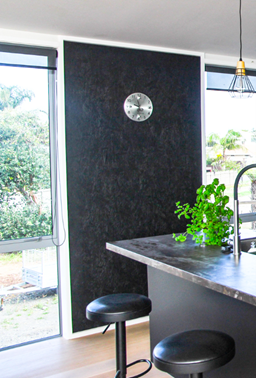9 - SIPs as an Interior Lining
Technical Bulletin #09
Created 11/05/21
Updated 24/04/23

Download FTB009 - Formance SIPs as an Interior Lining
The faces of a Formance panel are constructed from Oriented Strand Board, a unique structural material made up from natural wood fibers that are aligned during the manufacturing process to give the panel structural properties.
OSB is manufactured to stringent quality standards by certified plants. The manufacturer adds a “millmark” on the board after manufacture to identify the key characteristics of the board and to what standard it has been manufactured.
The most common option for finishing the interior of Formance SIP’s is to add a layer of plasterboard. In fact, most sheet material can be readily applied to the inside face of the SIP as a lining. The lining can be fixed directly to the panel or onto a service cavity as per Bulletin # FTB001.
However, for some projects, there may be a reason to leave the face of the Formance panels exposed and to direct finish the panels without an additional lining. If choosing this finish consideration will need to be given to the presence of the millmarks on the face of the OSB.
These millmarks can be removed by sanding the surface. A considerable effort is required to remove the marks and care needs to be taken not to remove excessive thickness of board, thus affecting the structural capacity. Mostly it is easier to use a solid darker colour to hide rather than remove the millmarks.
Other things to consider with exposed SIPs
- Orientation of the panels during the shop drawing process can affect the visual appearance and the alignment of panel joints may be irregular.
- The irregularities of the manufacturing process can cause the visual appearance of panels to be inconsistent,
- The sill plate can be seen and would need a skirting board to conceal it if desired.
- In some cases, a top plate packer is required, this can be seen on the interior unless concealed with a scotia or similar.
- The panels have a variable 3mm construction tolerance gap between them which may be inconsistent depending on the installation. This gap needs to be sealed with flexible/paintable silicon to ensure the joints are sealed properly.
- The perimeter of each panel has nails @ 150mm centres which are exposed and will be visible.
- OSB sheet edges can swell if overexposed to the elements during construction, affecting the look of the joints. Some joint sanding may be required.
- To reduce the affects of site moisture on panel surfaces it is recommended to choose the Formance prenail service to reduce the site exposure time by providing prenailed panels in large sections, rather than individual panels.
- White paints used directly on OSB can be problematic due to the appearance of random patches of tannin staining. Check with your paint supplier before choosing white or very light colours
- Exposed SIPs cannot be used on walls where fire-rated assemblies are required. Formance walls used in these situations require additional fire protection from linings. Refer to the Formance technical team for more information.

Figure 1 - Showing the interior of Formance SIP panels with typical millmarks

Figure 2- Exposed Formance SIP showing the use of solid colour paint
See accompanying Resene Spec below for guidance.
Formance Finishes
|
Contract: |
Interior |
|
Building: |
Residential |
|
Location: |
New Zealand |
|
Owner/Agent: |
Formance |
|
Specification No: |
050535-04-21/v1 |
|
Prepared By: |
David King - Resene Paints Ltd (NZ) |
|
Date: |
27 April 2021 |
Note – dark patches
For pigmented finishes, particularly in light colours, any tannin stains or dark timber visible through the Quick Dry and or Sureseal should be spot primed with Resene Stainlock before application of the top coats.
DRY AREA WALLS AND CEILINGS - PAINT, LOW SHEEN
DRY AREA WALLS AND CEILINGS - PAINT, FLAT
DRY AREA WALLS AND CEILINGS - PAINT, SEMI-GLOSS
DRY AREA WALLS AND CEILINGS - CLEAR COAT, SATIN
DRY AREA WALLS AND CEILINGS - STAINED AND CLEAR COAT, SATIN
DRY AREA WALLS AND CEILINGS - WHITEWASH AND CLEAR COAT, SATIN
WET AREA WALLS AND CEILINGS - PAINT, LOW SHEEN
WET AREA WALLS AND CEILINGS - PAINT, SEMI-GLOSS
DRY AREA FLOORS - CLEAR, SATIN
TIMBER JOINERY AND TRIMS - PAINT, SEMI GLOSS
TIMBER JOINERY AND TRIMS - CLEAR COAT, SATIN
Schedule of Paint Systems
|
DRY AREA WALLS AND CEILINGS - PAINT, LOW SHEEN paint new interior walls - particleboard, strandboard, MDF, plywood
|
|
|
|
Preparation |
Refer to SIPDS No. 2 Timber and Spec Sheet 2:14/1 |
|
|
Primer / Sealer |
1 coat of Resene Quick Dry - Primer Undercoat |
|
|
Topcoat System |
2 coats of Resene SpaceCote Low Sheen |
|
|
DRY AREA WALLS AND CEILINGS - PAINT, FLAT paint new interior walls - particleboard, strandboard, MDF, plywood
|
|
|
|
Preparation |
Refer to SIPDS No. 2 Timber and Spec Sheet 2:14/1 |
|
|
Primer / Sealer |
1 coat of Resene Quick Dry - Primer Undercoat |
|
|
Topcoat System |
2 coats of Resene SpaceCote Flat |
|
|
DRY AREA WALLS AND CEILINGS - PAINT, SEMI-GLOSS paint new interior walls - particleboard, strandboard, MDF, plywood
|
|
|
|
Preparation |
Refer to SIPDS No. 2 Timber and Spec Sheet 2:14/1 |
|
|
Primer / Sealer |
1 coat of Resene Quick Dry - Primer Undercoat |
|
|
Topcoat System |
2 coats of Resene Lustacryl - semi-gloss waterborne enamel |
|
|
DRY AREA WALLS AND CEILINGS - CLEAR COAT, SATIN clear coat new interior walls - particleboard, strandboard, MDF, plywood
|
|
|
|
Preparation |
Refer to SIPDS No. 2 Timber and Spec Sheet 2:10/1 |
|
|
Primer / Sealer |
--- no sealer or primer required --- |
|
|
Topcoat System |
3 coats of Resene Aquaclear - satin waterborne varnish |
|
|
DRY AREA WALLS AND CEILINGS - STAINED AND CLEAR COAT, SATIN clear coat new interior walls - particleboard, strandboard, MDF, plywood
|
|
|
|
Preparation |
Refer to SIPDS No. 2 Timber and Spec Sheet 2:10/1 |
|
|
Primer / Sealer |
1 coat of Resene Waterborne Colorwood - interior natural wood stain |
|
|
Topcoat System |
3 coats of Resene Aquaclear - satin waterborne varnish |
|
|
DRY AREA WALLS AND CEILINGS - WHITEWASH AND CLEAR COAT, SATIN clear coat new interior walls - particleboard, strandboard, MDF, plywood
|
|
|
|
Preparation |
Refer to SIPDS No. 2 Timber and Spec Sheet 2:10/1 |
|
|
Primer / Sealer |
1 coat of Resene Colorwood Whitewash |
|
|
Topcoat System |
3 coats of Resene Aquaclear - satin waterborne varnish |
|
|
WET AREA WALLS AND CEILINGS - PAINT, LOW SHEEN paint new interior walls - particleboard, strandboard, MDF, plywood
|
|
|
|
Preparation |
Refer to SIPDS No. 2 Timber and Spec Sheet 2:14/1 |
|
|
Primer / Sealer |
1 coat of Resene Sureseal and 1 coat of Resene Quick Dry - Primer Undercoat |
|
|
Topcoat System |
2 coats of Resene Room Velvet - low sheen hybrid waterborne-alkyd |
|
|
WET AREA WALLS AND CEILINGS - PAINT, SEMI-GLOSS paint new interior walls - particleboard, strandboard, MDF, plywood
|
|
|
|
Preparation |
Refer to SIPDS No. 2 Timber and Spec Sheet 2:14/1 |
|
|
Primer / Sealer |
1 coat of Resene Sureseal and 1 coat of Resene Quick Dry - Primer Undercoat |
|
|
Topcoat System |
2 coats of Resene Lustacryl - semi-gloss waterborne enamel |
|
|
DRY AREA FLOORS - CLEAR, SATIN clear coat new interior flooring - particleboard, strandboard, MDF
|
|
|
|
Preparation |
Refer to SIPDS No. 2 Timber and Spec Sheet 2:11/1 |
|
|
Primer / Sealer |
--- no sealer or primer required --- |
|
|
Topcoat System |
4 coats of Resene Qristal ClearFloor 1K - satin |
|
|
TIMBER JOINERY AND TRIMS - PAINT, SEMI GLOSS paint new interior joinery - windows, doors, skirting boards, shelving
|
|
|
|
Preparation |
Refer to SIPDS No. 2 Timber and Spec Sheet 2:9/1 |
|
|
Primer / Sealer |
1 coat of Resene Quick Dry - Primer Undercoat |
|
|
Topcoat System |
2 coats of Resene Lustacryl - semi-gloss waterborne enamel |
|
|
TIMBER JOINERY AND TRIMS - CLEAR COAT, SATIN clear coat new interior joinery - windows, doors, skirting boards, shelving
|
|
|
|
Preparation |
Refer to SIPDS No. 2 Timber and Spec Sheet 2:10/1 |
|
|
Primer / Sealer |
--- no sealer or primer required --- |
|
|
Topcoat System |
3 coats of Resene Aquaclear - satin waterborne varnish |
|
This specification needs to be used in conjunction with the relevant datasheets (available at www.resene.co.nz or hard copies available on request). Proper application of this specification will ensure the Resene paint system will adhere to the substrate it is applied to.
If the substrate has elements or issues not covered in the specification, including the surface information and preparation datasheets (SIPDS), and any additional supplementary information please contact Resene Technical Services for clarification and additional information. SIPDS refers to the Surface Information and Preparation Datasheets.
Substitutions are not permitted to any specified Resene coating system, or associated components and products, without approval from Resene Technical Services . Do not combine paints from different manufacturers in a paint system
Want to discuss your project? Get in touch here.
Looking for a builder? Check out our build partners around the country
Call us- 0800 000 527






